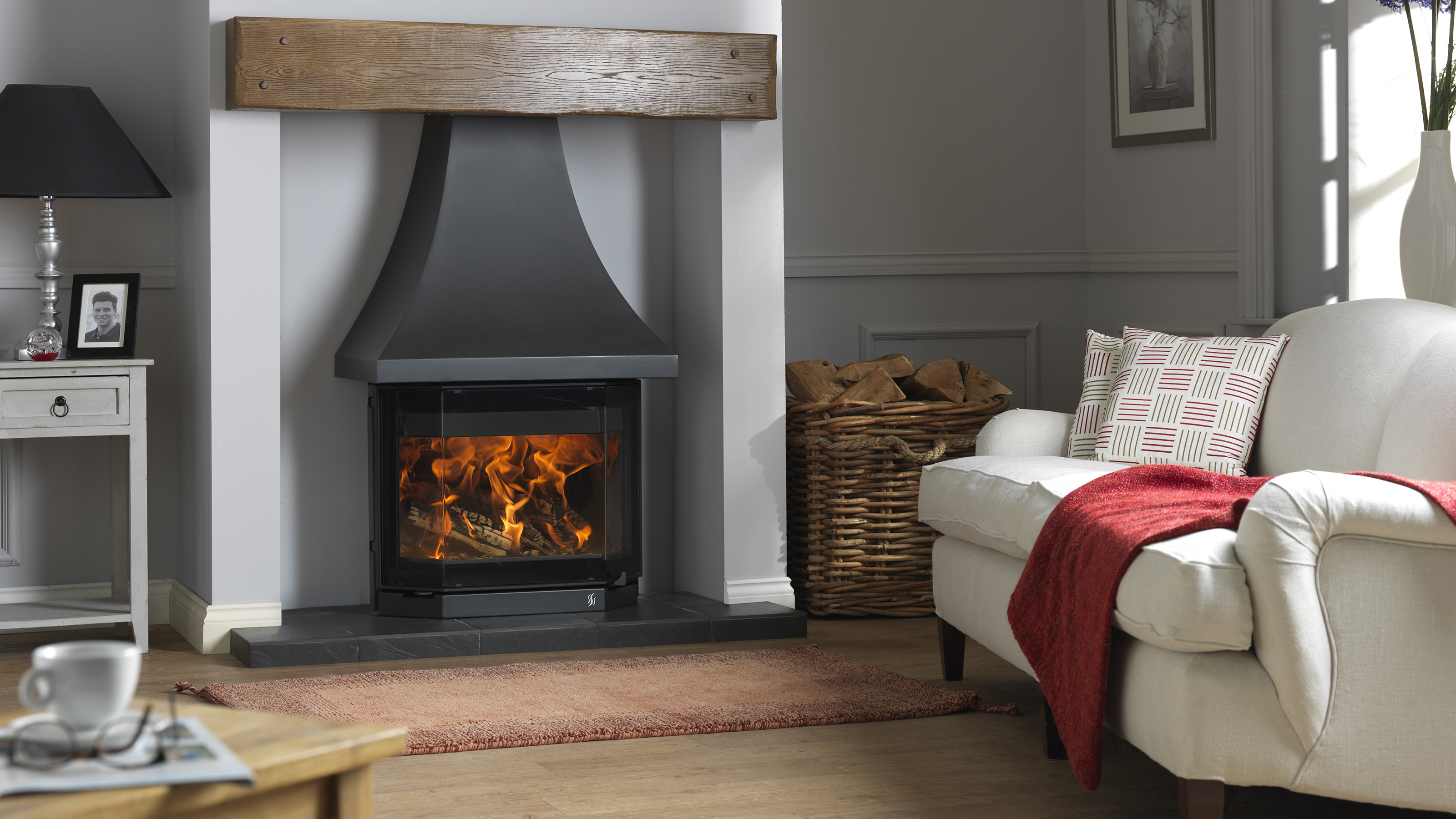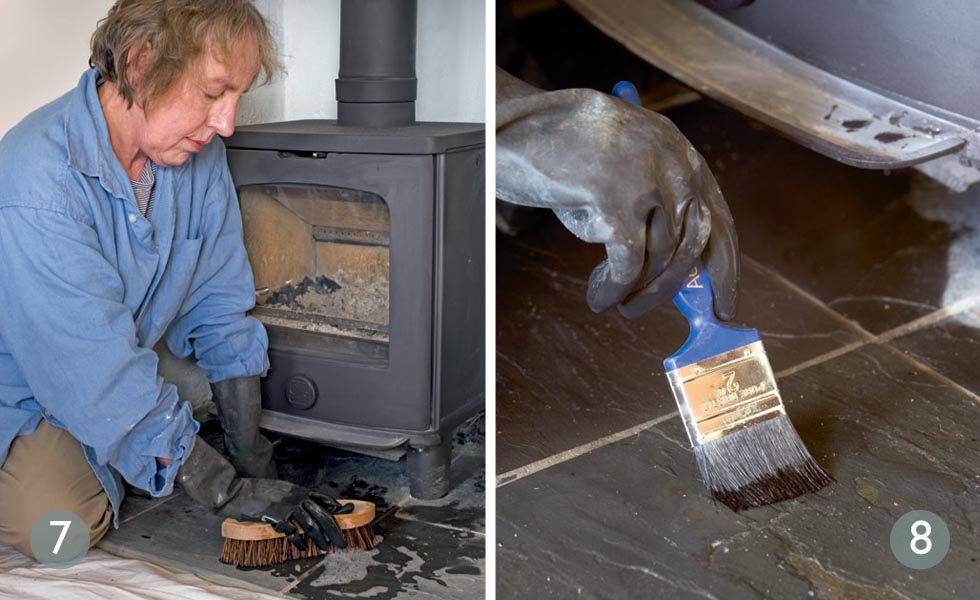How to clean a wood burning stove in 3 easy steps
Find out how to clean a wood burning stove inside and out with advice from the experts


It’s important to know how to clean a wood burning stove. It’s maintenance you should perform regularly so that it runs with maximum efficiency, of course. But it will also ensure your stove looks good and remains a wonderful focal point for a living space.
Along with the tasks essential to keeping it spick-and-span, you’ll need to be aware of how to clean the glass on a wood burning stove to get the best view of the flames that make a stove such a draw, and we’ve got the lowdown for you.
All you need to cozy up in style this heating season? The best wood burner ideas plus this wood stove cleaning guide and expert tips, which will have the job done in three easy steps.

How to clean a wood burning stove
You will need:
For cleaning
- Old towel or floor covers
- Protective gloves
- Ash pan or metal bucket and shovel
- Stove glass cleaner and cloths
- Vacuum cleaner and soft brush attachment or soft, lint-free cloth
For maintenance
- Stiff-bristled brush
- Stain blocker
- Heavy-duty floor cleaner and bristle brush
- Slate oil and brush
- Stove paint
- Medium grade steel wool
It’s vital to stay safe when cleaning wood burning stoves so before you start cleaning make sure yours is completely cool.
Get small space home decor ideas, celeb inspiration, DIY tips and more, straight to your inbox!
It’s also important to protect the floor area around the stove using an old towel or similar.
1. Clean the inside
Wear protective gloves. Ashes can be removed in an ash pan, then placed in a metal bucket. Alternatively, use a shovel along with a metal bucket. ‘Carefully gather the ashes in the shovel and gently slide them into the bucket,’ explains Jen Stark, founder of Happy DIY Home. ‘The ash can get into the air if you’re not careful and make a huge mess, so be sure to go slow.’
Be aware that ashes may still contain small embers. Leave them to cool outside for a few days before disposal.
Note that this is something you should do regularly during the heating season. ‘Even a pure wood burning stove produces ash though far less than multi fuel stoves burning smokeless fuel,’ explains Declan Kingsley-Walsh, managing director at Morsø UK. ‘Ashes will need to be removed a couple of times a day when using smokeless fuel but as little as once a week when burning wood. You will need a good size ash pan for ease of cleaning and removal of ashes.’
2. Wipe down the glass
To maintain the optimum view of the flames, you should clean the glass of a wood burning stove. To do so, wipe it with stove glass cleaner, leave for five minutes, then remove with a damp rag.
‘It’s important you choose the right kind of glass cleaner as printed glass requires a different cleaning product than plain door glass,’ explains Michael Coke, biomass product development manager at Stovax. ‘If there is any damage, the door glass will need replacing.’
Does the glass look sooty? Be aware that this can indicate that it is not burning efficiently. ‘Sooty glass can be the result of a draft or lighting the fire incorrectly; tarred glass is due to the use of wood with excessive moisture content (above 20 per cent),’ says Anthony Barton, group technical manager, Jøtul.
Sooty glass can be cleaned effectively, though. ‘Soot is easily removed with the wood ashes in the stove, but never use coal ash as this will scratch the glass,’ says Anthony. ‘Simply dampen a cloth and dip it into the ashes. Rub in a circular motion and the soot should come off easily.’
3. Clean the outside
The easiest way to clean the exterior of the stove might be to use a vacuum cleaner and the soft brush attachment. As an alternative, you could use a cloth, but keep it dry; a damp cloth could rust the stove eventually.
Make sure you go gently when it comes to cleaning the exterior. ‘Stoves should not be polished,’ says Declan Kingsley-Walsh. ‘Any light dust can be wiped away with a lint-free cloth.’
Outside of the stove already rusted? To remove rust patches from a wood burner, cut a pad of medium grade steel wool to rub away the rust and, wearing protective gloves, gently work away at it until it vanishes. With a brush and dustpan sweep up the mess, and use a stove brush or clean shoe brush to clear dirt off the surface ready for painting.
Before painting, mask the glass doors and metal handles with newspaper and tape. Protect the walls and hearth, too, if you are painting the whole appliance. Before applying the paint, open doors and windows to ensure good ventilation. Hold the can about 10 to 12 inches (25 to 30cm) away from the surface and spray the stove.
If you want to restore a black wood stove, you might want to use Rust-oleum's stove and BBQ paint. It has a heat-resistant finish, is quick drying and is durable plus it stops rust and resists heat up to 1200ºF (648ºC). Allow to dry for at least one hour before heating.

Wood burner maintenance
It’s important to maintain a wood stove, plus there are additional cleaning jobs you might need to do. Here are the details.
Check the rope seal on your stove
Over time the rope seal around the door will flatten and lose its shape, affecting the stove’s efficiency and allowing fumes to leak out.
Set a small fire and close the doors and air intakes. Move a lit candle around the door – if the flame is drawn towards it a poor seal is indicated and the rope needs replacing.
Health check a wood burning stove
To health check a wood stove, clean out the firebox and empty the ash pan. Shine a torch inside to check that the firebricks are not broken. Leave the air inlets open and the door ajar to allow a flow of air through the chimney to keep it dry.
Remove soot and tar marks on the walls
If soot and tar deposits have migrated through the plaster from the brick chimney breast, brush away dirt and apply a coat of stain block. If necessary, apply a second coat two hours after the first one has dried. Once dry the surface can be over-painted with any type of paint.

Reseal the hearth
Sealing a slate hearth will enhance the color and make it easier to clean.
First sweep up loose dirt and ash then, with heavy-duty floor cleaner and hot water, scrub the hearth, mopping up the water as you work. Wipe over with clean water and dry with an old towel.
Leave for at least four days before applying sealer.
- Find all our fireplace hearth ideas for more toasty inspo.
Apply slate oil to the hearth
Slate oil will repel dirt and ash while still allowing the slate to breathe, so it could reduce your cleaning chores without harming the stone.
Note that some stone care products mustn’t be used where the temperature is likely to exceed 77ºF (25ºC) so always read the guidance on the product.
Before you start, protect rugs or carpet from splashes then apply the oil evenly with a brush or sponge. Allow to dry for two hours.
How often should I clean my wood burning stove?
Typically, you should clean your wood burning stove at least once a month (it’s fine if you haven’t cleaned it since spring if you haven’t been using it over the summer). During periods of heavy use, you may need to increase the cleaning frequency to every two weeks, or even once a week. The cleaner the stove is, the more efficiently it’ll run, so it’s a good idea to keep it spick-and-span.
‘Proper functioning of a stove, its seals, gaskets and the chimney draw, can all affect emissions,’ says Phil Wood, UK country manager for Contura. ‘When everything works optimally, the appliance will run at its cleanest and most efficient.
‘And it is maintenance that will achieve optimum performance,’ he continues. ‘The chimney, flue and stove should be swept professionally at least once a year. An annual check is crucial to troubleshoot any issues, check all parts are functioning correctly and remove any soot and blockages that may be affecting the efficiency and emissions of your stove. Set an annual reminder to get your chimney sweep appointment booked in.’
How do you remove ash from a wood stove?
You can remove ash from a wood stove manually using the method above, but an alternative is to invest in a special ash vacuum. ‘An ash vacuum is usually made from metal parts to avoid any plastic components melting, as well as being flame retardant,’ explains Davinder Sangha of Schiedel Chimney Systems. ‘They also have different filter systems to normal vacuums.’
After that? ‘Normally it’s recommended to dispose of wood ash with household waste, but it can also be recycled within a compost heap or a soil patch,’ says Davinder. ‘However, be wary as heavy use could damage plants and the soil.
‘When adding to the soil, it’s recommended to do this in the wintertime, and it must be raked in rather than laying on the surface. If this is something you would be doing regularly, then doing a pH test on the soil to test its acidity is recommended.
‘Note that this is for wood ash. Coal ash adds no value to any soils.’
How do you clean a cast iron wood stove?
You can both clean and renew a cast iron wood stove. ‘Even though cast iron is a long-lasting material, it is susceptible to corrosion,’ explains Susan Melony, shopping expert at Product Diggers. ‘With a little elbow grease, remove rust from the inside and outside of the wood stove. The rusty portions can be removed with a firm wire-bristle brush or medium-grade steel wool.
‘After washing away the rust using cast iron polish, wood stove paint, or cast iron blackening paste the stove will appear fresher. Select items that can survive the high heat of a wood-burning stove. Follow the package directions for applying the paste, paint, or polish.’